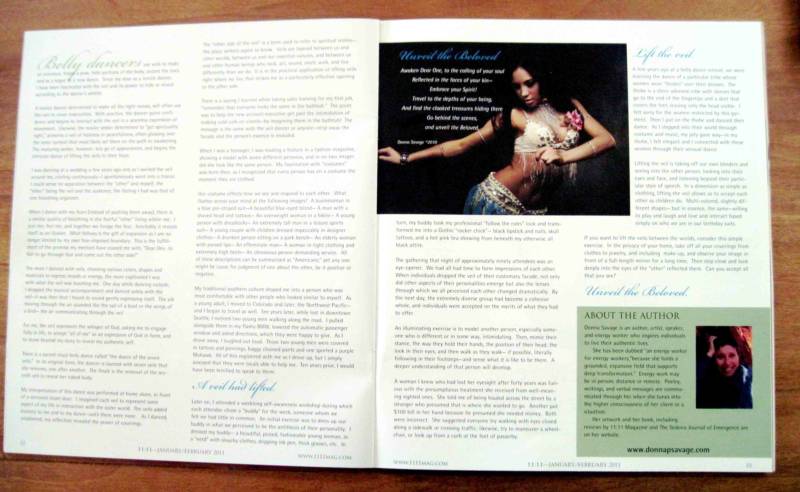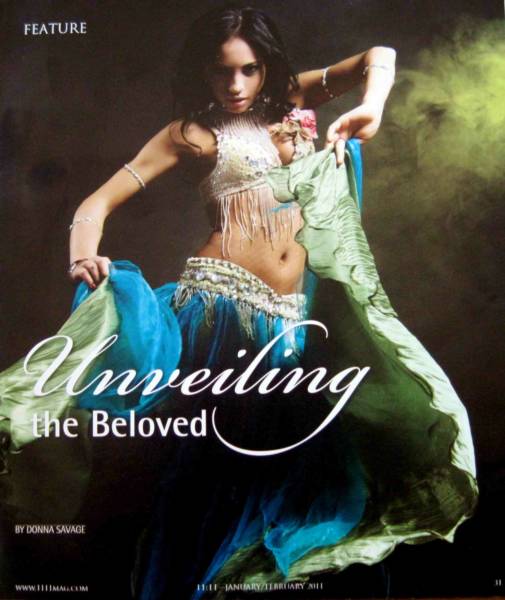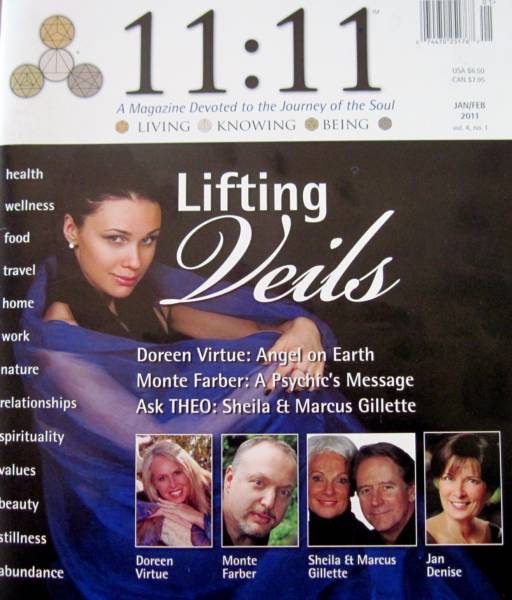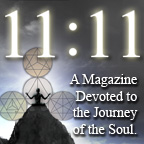Belly dancers use veils to make an entrance, frame a pose, hide portions of the body, accent the eyes, and as a segue to a new dance. Since my days as a novice dancer, I have been fascinated with the veil and its power to hide or reveal according to the dancer’s whelm.
A novice dancer determined to make all the right moves, will often use the veil to cover insecurities. With practice, the dancer gains confidence and begins to interact with the veil in a seamless expression of movement.
Likewise, the novice seeker determined to “get spirituality right,” presents a veil of holiness or peacefulness, often glossing over the inner turmoil that most likely set them on the path to awakening. The maturing seeker, however, lets go of appearances, and begins the intricate dance of lifting the veils to their fears.
I was dancing at a wedding a few years ago and as I swirled the veil around me, circling continuously—I spontaneously went into a trance. I could sense no separation between the “other” and myself, the “other" being the veil and the audience; the feeling I had was that of one breathing organism.
When I dance with my fears (instead of pushing them away), there is a similar quality of breathing in the fearful “other” living within me. I join her, feel her, and together we forage the fear. Inevitably it reveals itself as an illusion. What follows is the gift of expansion as I am no longer limited by my own fear-imposed boundary. This is the fulfillment of the promise my mentors have coaxed me with, “Dear One, its fun to go through fear and come out the other side!”
The more I danced with veils, choosing various colors, shapes and materials to express moods or energy, the more captivated I was with what the veil was teaching me. One day while dancing outside, I dropped the musical accompaniment and danced solely with the veil—it was then that I heard its sound gently expressing itself. The silk moving through the air sounded like the sail of a boat or the wings of a bird— the air communicating through the veil.
For me, the veil represents the whisper of God, asking me to engage fully in life, to accept “all of me” as an expression of God in form, and to move beyond my story to reveal my authentic self.
There is a sacred ritual belly dance called “the dance of the seven veils.” In its original form, the dancer is layered with seven veils that she removes, one after another. The finale is the removal of the seventh veil to reveal her naked body.
My interpretation of this dance was performed at home alone, in front of a mirrored closet door. I imagined each veil to represent some aspect of my life in interaction with the outer world. The veils added mystery to me and to my dance—until there were none. As I danced, unadorned, my reflection revealed the power of coverings.
The “other side of the veil” is a term used to refer to spiritual realms— the place seekers aspire to know. Veils are layered between us and other worlds, between us and our essential natures, and between us and other human beings who look, act, sound, smell, walk, and live differently than we do. It is in the practical application of lifting veils right where we live that strikes me as a particularly effective opening to the other side.
There is a saying I learned while taking sales training for my first job, “remember that everyone looks the same in the bathtub.” The point was to help the new account executive get past the intimidation of making cold calls on clients—by imagining them in the bathtub!
The message is the same with the veil dancer or anyone—strip away the facade and the person’s essence is revealed.
When I was a teenager, I was reading a feature in a fashion magazine, showing a model with seven different personas, and in no two images did she look like the same person. My fascination with “costumes” was born then, as I recognized that every person has on a costume the moment they are clothed.
Our costume effects how we see and respond to each other. What flashes across your mind at the following images? A businessman in a blue pin-striped suit—A beautiful blue-eyed blond— A man with a shaved head and tattoos— An overweight woman in a bikini— A young person with dreadlocks— An extremely tall man in a leisure sports suit— A young couple with children dressed impeccably in designer clothes— A drunken person sitting on a park bench— An elderly woman with pursed lips— An effeminate man— A woman in tight clothing and extremely high heels— An obnoxious person demanding service. All of these descriptions can be summarized as “Americans;” yet any one might be cause for judgment of one about the other, be it positive or negative.
My traditional southern culture shaped me into a person who was most comfortable with other people who looked similar to myself. As a young adult, I moved to Colorado and later, the Northwest Pacific— and I began to travel as well. Ten years later, while lost in downtown Seattle, I noticed two young men walking along the road. I pulled alongside them in my flashy BMW, lowered the automatic passenger window and asked directions, which they were happy to give. As I drove away, I laughed out loud. Those two young men were covered in tattoos and piercings, baggy chained pants and one sported a purple Mohawk. All of this registered with me as I drove up, but I simply assessed that they were locals able to help me. Ten years prior, I would have been terrified to speak to them.
A veil had lifted.
Later on, I attended a weeklong self-awareness workshop during which each attendee chose a “buddy” for the week, someone whom we felt we had little in common. An initial exercise was to dress up our buddy in what we perceived to be the antithesis of their personality.
I dressed my buddy— a beautiful, poised, fashionable young woman, as a “nerd” with slouchy clothes, dripping ink pen, thick glasses, etc. In turn, my buddy took my professional “follow the rules” look and transformed me into a Gothic “rocker chick”— black lipstick and nails, skull tattoos, and a hot pink bra showing from beneath my otherwise all black attire.
The gathering that night of approximately ninety attendees was an eye-opener. We had all had time to form impressions of each other. When individuals dropped the veil of their customary facade, not only did other aspects of their personalities emerge but also the lenses through which we all perceived each other changed dramatically. By the next day, the extremely diverse group had become a cohesive whole, and individuals were accepted on the merits of what they had to offer.
An illuminating exercise is to model another person, especially someone who is different or in some way, intimidating. Then, mimic their stance, the way they hold their hands, the position of their head, the look in their eyes, and then walk as they walk— if possible, literally following in their footsteps—and sense what it is like to be them. A deeper understanding of that person will develop.
A woman I knew who had lost her eyesight after forty years was furious with the presumptuous treatment she received from well-meaning sighted ones. She told me of being hauled across the street by a stranger who presumed that is where she wanted to go. Another put $100 bill in her hand because he presumed she needed money. Both were incorrect. She suggested everyone try walking with eyes closed along a sidewalk or crossing traffic; likewise, try to maneuver a wheelchair, or look up from a curb at the feet of passerby.
Lift the veil.
A few years ago at a belly dance retreat, we were learning the dance of a particular tribe whose women wore “thobes” over their dresses. The thobe is a sheer adorned robe with sleeves that go to the end of the fingertips and a skirt that covers the feet, leaving only the head visible. I felt sorry for the women restricted by this garment. Then I put on the thobe and danced their dance. As I stepped into their world through costume and music, my pity gave way—in my thobe, I felt elegant and I connected with these women through their sensual dance.
Lifting the veil is taking off our own blinders and seeing into the other person, looking into their eyes and face, and listening beyond their particular style of speech. In a dimension as simple as clothing, lifting the veil allows us to accept each other as children do. Multi-colored, slightly different shapes— but in essence, the same—willing to play and laugh and love and interact based simply on who we are in our birthday suits.
If you want to lift the veils between the worlds, consider this simple exercise. In the privacy of your home, take off all your coverings from clothes to jewelry, and including make-up, and observe your image in front of a full-length mirror for a long time. Then step close and look deeply into the eyes of the “other” reflected there. Can you accept all that you see?
Unveil the Beloved.
11:11 MAGAZINE FEATURE WRITER
UNVEILING THE BELOVED
by Donna P. Savage
As published in 11:11 Magazine Issue January - February 2011
Unveil the Beloved
Awaken Dear One, to the calling of your soul
Reflected in the faces of your kin—
Embrace your Spirit!
Travel to the depths of your being,
And find the cloaked treasures hiding there
Go behind the scenes,
and unveil the Beloved.
Donna Savage ©2010
Donna Marie Pritchard | P.O.Box 3343 Ketchum, ID 83340 | Email: donnapsavage@live.com | 24 Hour Message Center: 803-360-6255
All content on this website is the property and copyright of Donna Marie Pritchard. Any use or reproduction of this material without expressed permission is punishable by Federal Law.
"The most important thing ... is to give
up who you are for who you can become."
DONNA MARIE PRITCHARD







